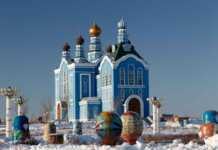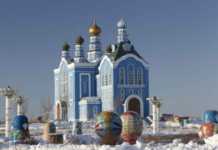The land of temples, islands and palaces, Thailand has a rich heritage and fascinating history. As the only Southeast Asian country that wasn’t colonised by Europeans, Thailand’s culture remains intact and its palaces are as grand as they were centuries ago. From vibrant cities to white-sand islands and lush tropical hills, these Thailand landmarks should be on your bucket list. Many of the most famous landmarks in Thailand are gorgeous temples and elaborate palaces that tell a story of the country’s rich cultural heritage but there are plenty of natural formations that are impressive too.
Contents
- 31 Thailand Landmarks For Your Bucket List
- Best Landmarks in Bangkok
- Historical Landmarks in Thailand
- Natural Thailand Landmarks
- 21- Doi Inthanon Mountain
- 22- James Bond Island (Khao Ping Kan)
- 23- Erawan Waterfall
- 24- Haew Suwat Waterfall in Khao Yai National Park
- 25- Cheow Lan Lake in Khao Sok National Park
- 26- Maya Bay
- 27- Thi Lo Su Waterfall
- 28- Emerald Pool (Sa Morakot)
- 29- Sam Phan Bok
- 30- The Red Lotus Sea (Talay Bua Daeng)
- 31- Pha Taem National Park
31 Thailand Landmarks For Your Bucket List
Best Landmarks in Bangkok
1- Grand Palace
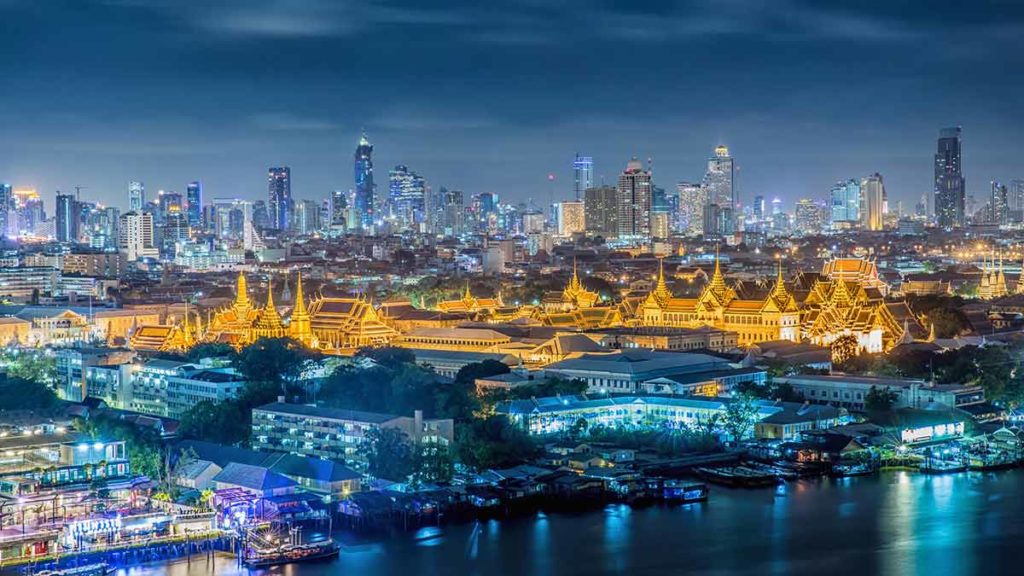
Once the residence of the Thai Royal Family, the Grand Palace in Bangkok is now a museum and one of the most visited Thailand landmarks in the country.
The Grand Palace is a sprawling collection of buildings in the centre of Bangkok built over several years.
King Rama I started constructing the Grand Palace in 1782 using timber at first.
Later during the project, bricks salvaged from the Ayutthaya ruins were transported along Chao Phraya River after Ayutthaya ceased being the capital of Thailand in 1767.
The highlight of the Grand Palace is the Emerald Buddha in Wat Phra Kaew, which is the most important Buddha statue in Thailand.
When visiting the Grand Palace, dress modestly (long pants for men and no bare shoulders) as this is considered a sacred site.
The Grand Palace is at Na Phra Lan Rd, Khwaeng Phra Borom Maha Ratchawang, Khet Phra Nakhon, Krung Thep Maha Nakhon 10200, Thailand. Admission fee is 500 Baht (free for Thai nationals) and is open from 8.30 am to 3.30 pm daily.
Stay at: Eastin Grand Hotel Sathorn
2- Marble Temple
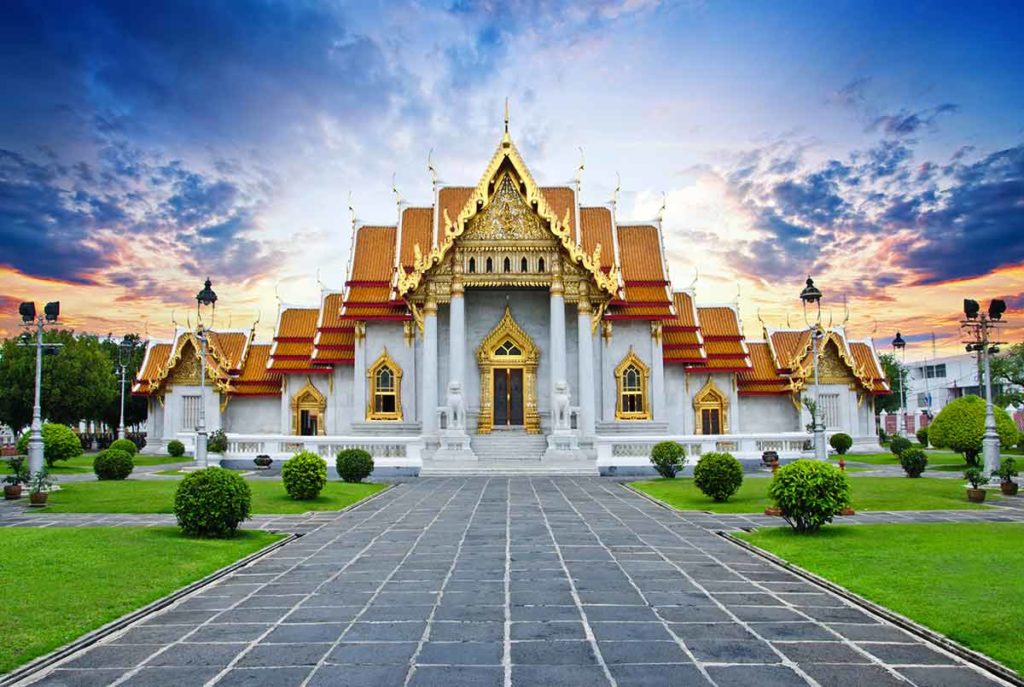
If you look on the back of a five baht coin, you’ll recognise this Thai landmark.
Wat Benchamabophit is known as the Marble Temple because it’s constructed from white marble imported from Italy.
Built during the late 19th century by Rama V, the temple’s architecture is an excellent example of classical Thai design.
If you’ve seen the “King and I”, you’ll feel like the temple is straight out of the play, and fans of The Amazing Race 9 might recognise the temple as the final place where contestants were eliminated.
Inside the ubosot (ordination hall), there’s a serene Sukhothai-style Buddha created in 1920, standing above the spot where King Chulalongkorn’s ashes lie.
Equally as impressive are the 52 Buddha statues with every pose from Thailand’s Buddhist history represented.
It’s also home to the Benchamabophit National Museum.
Wat Benchamabophit is at 22, 200 Nakhon Ratchasima Rd, Khwaeng Dusit, Khet Dusit, Krung Thep Maha Nakhon 10300, Thailand.
Recommended tour: Bangkok: Markets, Temples and Food Night Tour by Tuk Tuk
Stay at: Kingfisher House
3- Wat Arun
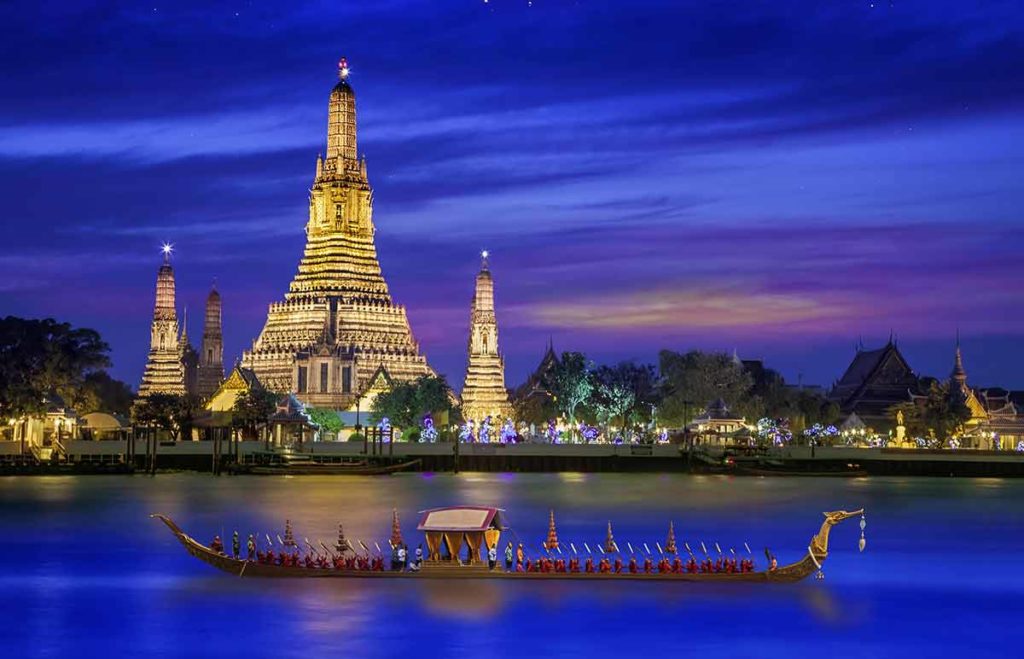
Also known as the Temple of Dawn, Wat Arun is a Buddhist temple built by King Narai in the 17th century.
It’s called the Temple of Dawn because it’s incredibly beautiful at dawn when the first rays of light shine down on the temple to create an esoteric gleam.
Named after the Hindu god Aruna, the temple’s central Khmer-style tower (or prang) soars 82 m above the landscape and is what makes the temple one of the most famous landmarks in Thailand.
During the 18th century, Wat Arun was part of the palace grounds home to Bangkok’s revered Emerald Buddha (which is now in the Grand Palace).
The central tower is surrounded by smaller towers and decorated with figurines of Chinese soldiers, animals, Hindu gods and Buddhist icons.
Climb the temple’s tower for a fantastic view of the Chao Phraya River and explore the grounds, making sure not to miss the ordination hall (or ubosot).
Wat Arun is at 158 Wang Doem Rd, Wat Arun, Bangkok Yai, Bangkok, Thailand,
Stay at: Chatrium Grand Bangkok
4- Wat Pho
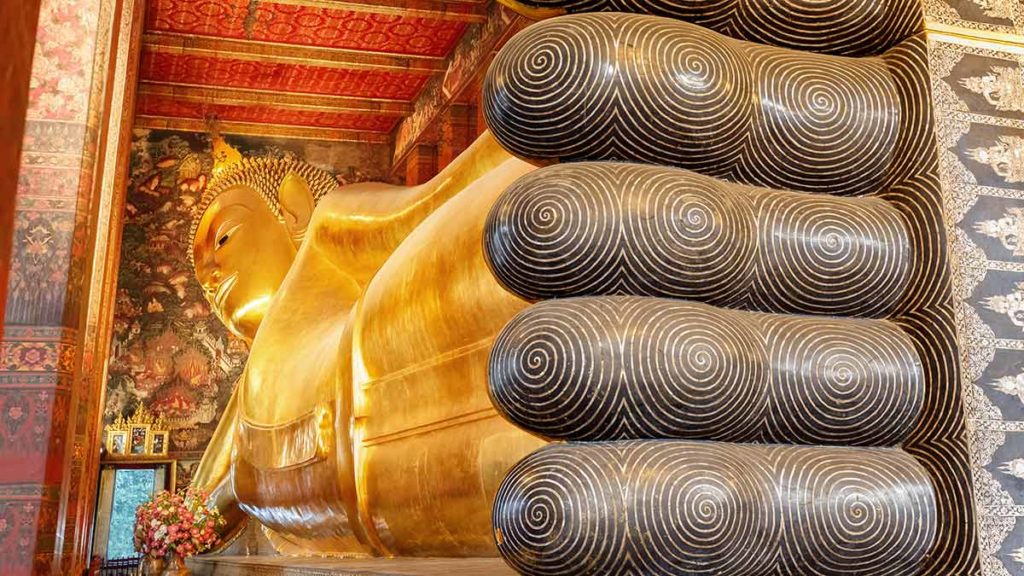
As the oldest temple in Bangkok, Wat Pho is one of six top-tier royal temples and another landmark in Thailand to tick off your bucket list.
Wat Pho is also the largest temple in Bangkok and home to Bangkok’s most impressive reclining Buddha.
The statue is 46 m long by 15 m high with enormous 5m feet decorated in mother of pearl.
As Wat Pho is just a 10-minute walk from the Grand Palace, it’s worth planning your visit to see both landmarks.
There’s also a traditional Thai massage school on the grounds, where you can experience the healing power of Thai massage.
Wat Pho is at 2 Sanamchai Road, Grand Palace Subdistrict, Pranakorn District, Bangkok 10200.
Stay at: Chakrabongse Villas
5- State Tower
Picture yourself sipping a Mai Tai while gazing at the view over Bangkok from one of the highest bars in the world.
One of Bangkok’s tallest buildings, the State Tower is a soaring 247 m skyscraper in the concrete jungle of Bangkok’s Silom district.
This 21st-century Thai landmark is an architectural feat and has 68 floors with offices, apartments and shops.
Its famous Sky Bar was featured in the movie The Hangover Part II.
The circular bar is a Bangkok landmark and sipping a cocktail in the highest open-air sky bar in the world is one of the things to do in Bangkok for your bucket list.
Treat yourself to a stay at lebua hotel and make it a visit to Bangkok you’ll always remember.
Book your accommodation at Lebua State Tower here
State Tower is at 1055 Silom Road, Bangrak, Bangkok, Thailand.
Stay at: GM Residence
More Landmarks in Asia:
6- Rama VIII Bridge
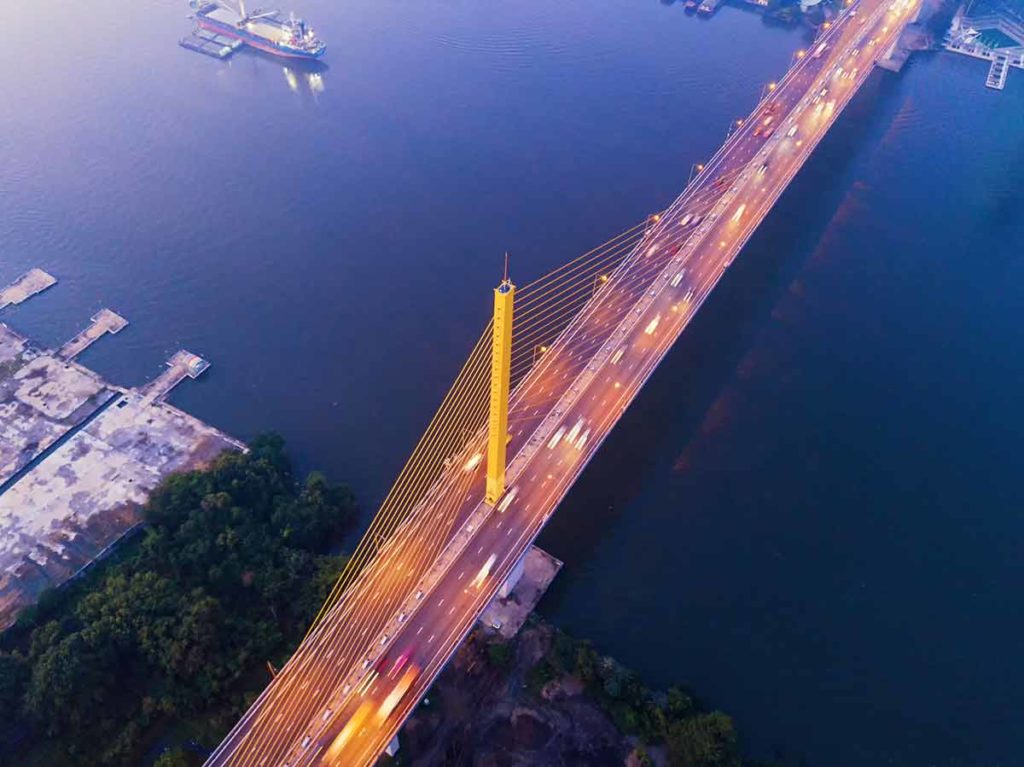
As a city built around one of the world’s most iconic rivers, Bangkok is also a city of bridges.
One bridge, in particular, Rama VIII Bridge is a manmade landmark in Thailand that you can see from most of Bangkok’s sky bars.
The Bridge stretches across Thailand’s Chao Phraya River and is an impressive engineering structure that is 475 m (1,437 ft) long.
Constructed in 2002, it’s one of the largest asymmetric cable-stayed bridges in the world.
Stay at: Siam Kempinski Hotel Bangkok
7- Chao Phraya River
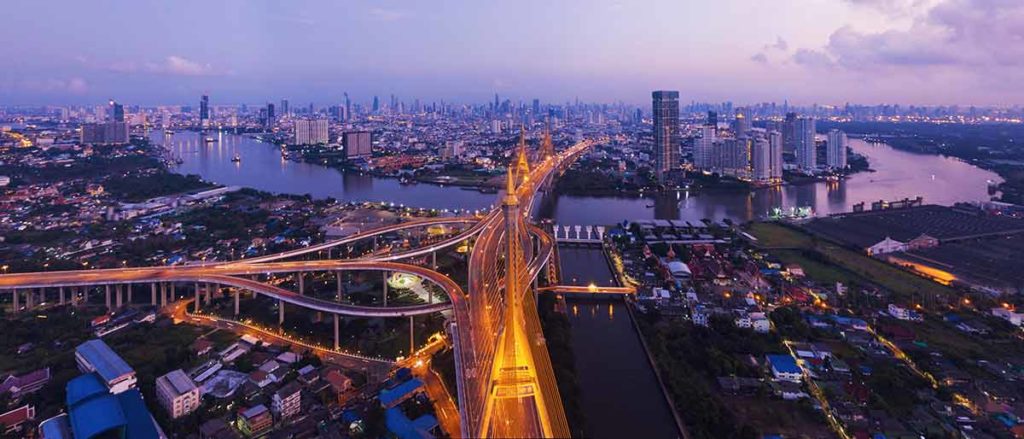
The River of Kings, the Chao Phraya River, is the lifeblood of Thailand and many communities have thrived along the banks of this river.
Menam Chao Phraya is a working river and in Bangkok, more than 50,000 people a day use its ferries to travel around the city.
A busy waterway with cargo barges, long-tail boats and leisure crafts, the river is a source of income, a means of transportation and an impressive natural landmark of Thailand.
While in the Thai capital, follow the river and you’ll find yourself visiting many of Bangkok’s top attractions, including the spectacular Grand Palace and Wat Phra Kaew, Wat Pho and Wat Arun.
The river and its many canals (or khlongs) earned Bangkok the title “Venice of the East” and you can access these khlongs from the Chao Phraya River, Klong Saen Saeb or the Klongs of Thonburi.
The 365 km Chao Phraya River flows from the province of Nakhon Sawan through Bangkok to the Gulf of Thailand.
Stay at: The Salil Hotel Riverside Bangkok
8- Damnoen Saduak Floating Market
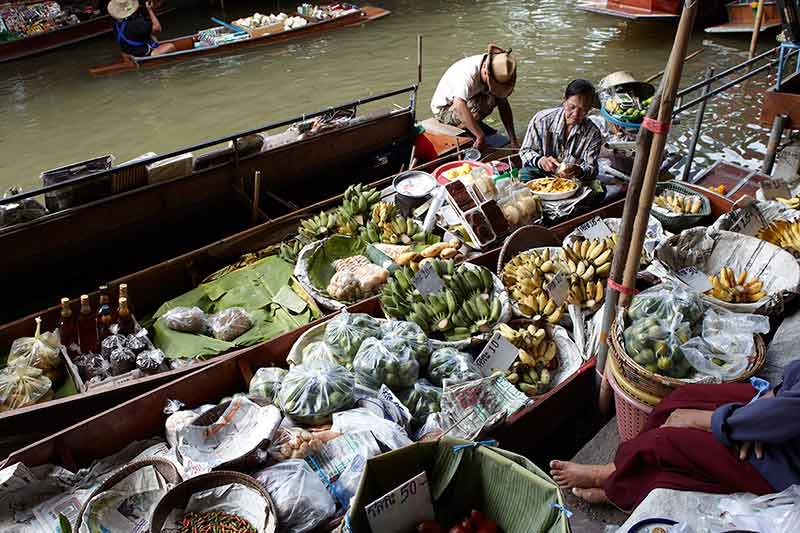
Thailand is well-known for its floating markets, where generations of vendors go to sell fruit and vegetables, clothes and souvenirs from long-tail boats.
The most visited is the Damnoen Saduak Floating Market, which is not far from Bangkok and can be visited as a day trip.
Located in the Ratchaburi province,100 km southwest of Bangkok, the floating market is a landmark in Thailand and a magnet for thousands of tourists keen to see how shopping is done while floating in these boats.
If you’re a fan of markets, there are several other floating markets near Bangkok, including the smaller and more local Khlong Lat Mayom.
Stay at: Yunoya Riverside Villa
Historical Landmarks in Thailand
9- Bridge Over the River Kwai
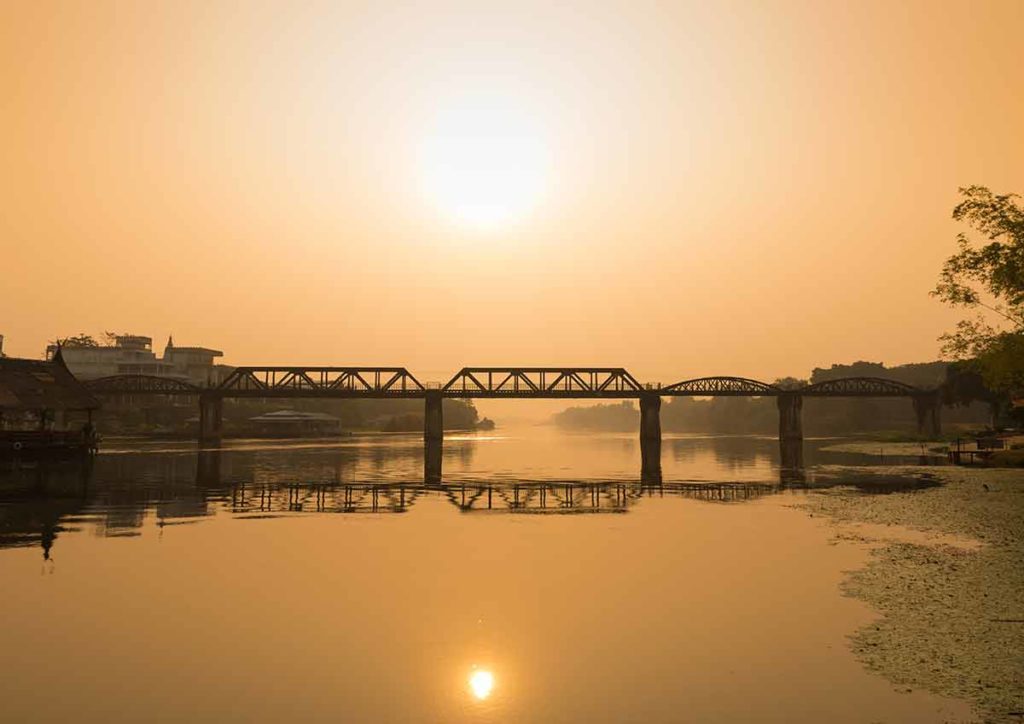
Of all the Thailand landmarks, the Bridge Over the River Kwai is the one that will remind you most of the horrors of World War II.
The famous iron bridge was part of the Death Railway to Burma built by Allied prisoners of war who were forced to labour under shocking conditions.
Visit the museum and information centre, which has displays and photographs that depict the difficult conditions endured by the Prisoners of War, who were forced into hard labour to build the Death Railway bridge.
The museum is funded by both Australian and Thai governments and describes how this part of Thailand was named Hellfire Pass.
You can walk across the Bridge or catch a train from Bangkok’s Thonburi station (Bangkok Noi) for Kanchanaburi and on to the River Kwai Bridge station which then crosses the Bridge and runs alongside the River Kwae to Nam Tok.
Stay at: The Parrot Inn Kanchanaburi
10- Sukhothai Historical Park
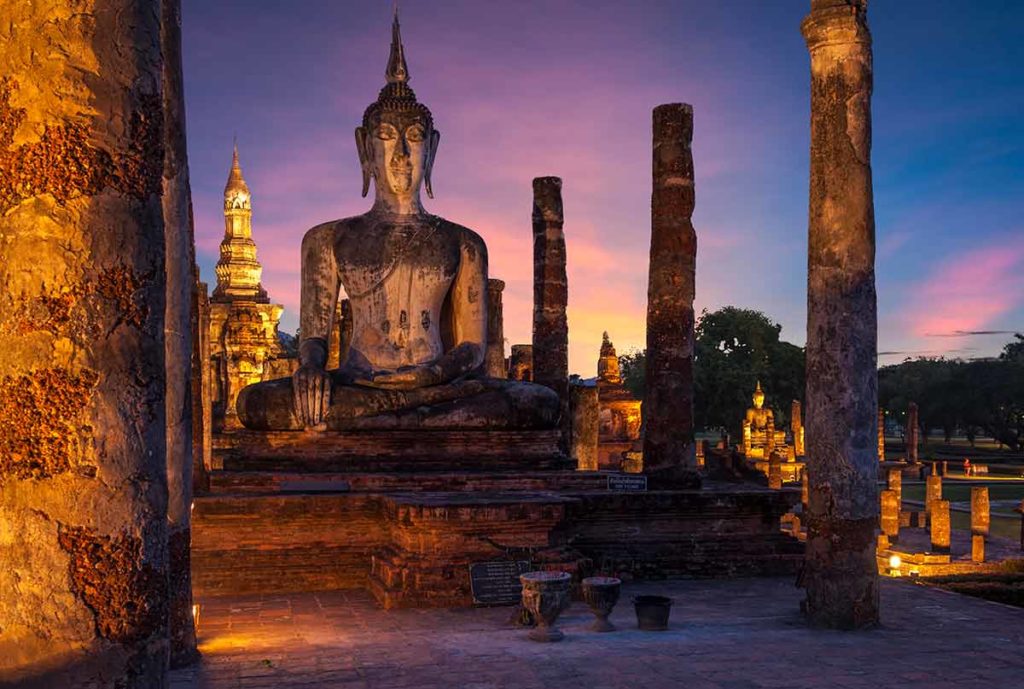
Sukhothai Historical Park is home to one of the most impressive collections of Thailand landmarks.
One of the reasons why Sukhothai Historical Park is an enchanting place to visit is that the UNESCO World Heritage City was the first capital of Siam and the birthplace of Thai culture.
The Sukhothai Kingdom (1238 to 1438) represented a romantic era when it was the centre of culture, language, art and architecture in Thailand.
The UNESCO World Heritage site houses the remains of one of Thailand’s ancient capitals, with structures dating back to the 13th and 14th centuries.
Temple ruins, Buddha statues, bridges and other attractions in the park are sprawled across a large area that was once Ancient Siam.
Visiting Sukhothai Historical Park is an excellent opportunity to see a well-preserved piece of Thai history.
Stay at: Dorm of Happiness by Tharaburi Resort
11- Wat Phra Mahathat
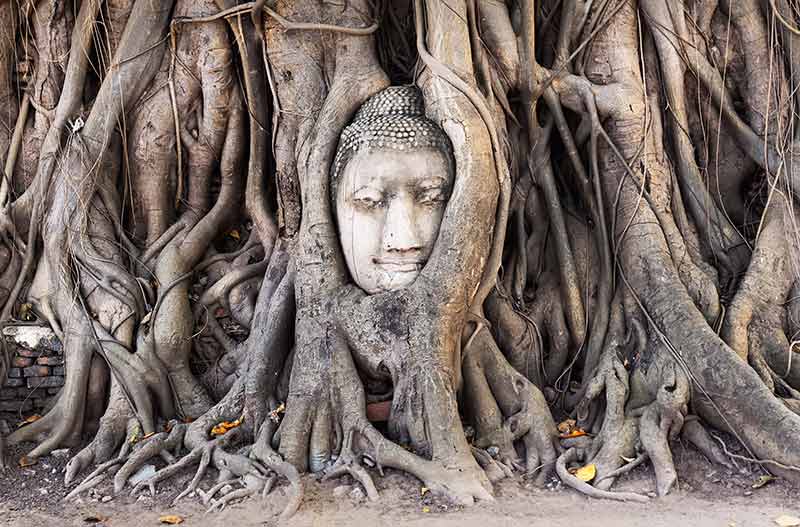
A large stone Buddha head wedged in a massive deep-rooted tree is just one of the historic sites in Ayutthaya.
The 14th-century city was Siam’s second capital and is home to a treasure trove of other ancient wonders, such as Wat Chaiwatthanaram (with its 120 sitting Buddha statues), Wat Lokaya Sutha (with its restored ruins and reclining Buddha statue) and the UNESCO World Heritage Ayutthaya Historical Park.
It’s not clear how the Buddha’s head became wedged in its current location, however, one theory is that it was pushed there by floods.
If you’d rather believe a legend, there’s one that says that two brothers fought over who would succeed as the King of Siam and the victor, King Ramathibodi I, built the palace and all the Buddha statues to honour his defeated brother.
You can do a day tour from Bangkok to Ayutthaya or if you’d like to stay a little longer, book a hotel in Ayutthaya here. This ancient city is definitely worth visiting.
Stay at: Nakhao Cottage
12- Sanphet Prasat Palace
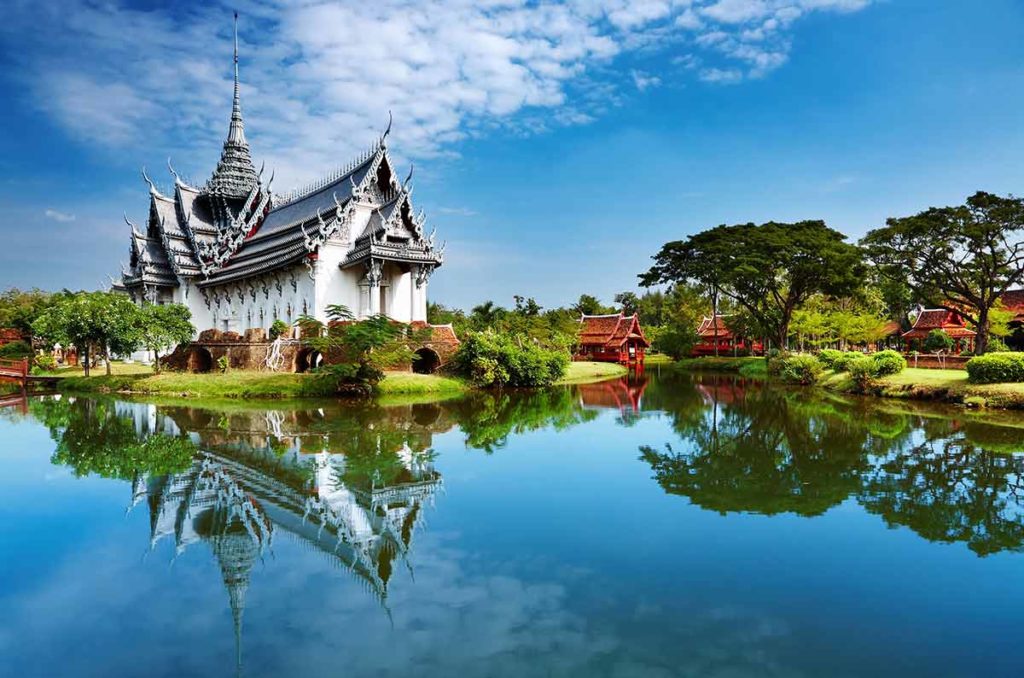
The main palace in Ayutthaya was Sanphet Prasat Palace, which was constructed for Ayutthaya’s eighth king and used for official ceremonies.
With tapered pillars, ornate decorations and spires, the architectural style of the palace is distinct from Khmer and Sukhothai designs.
The Burmese captured Ayutthaya in 1767 AD and burned the palace to its brick basement.
Fortunately, historians have been able to reconstruct this famous Thai landmark by extensively researching the ruins.
Two wings flank a central hall and the Mother-of-Pearl inlaid doors and windows are testimony the importance of this palace.
The King of Thailand used this palace to welcome Queen Elizabeth II in 1972 on the day Ayutthaya was officially declared open.
Sanphet Prasat Palace is at Phra Nakhon Si, Ayutthaya.
Stay at: Na Klongluang Boutique Resort
13- Prasat Hin Phimai
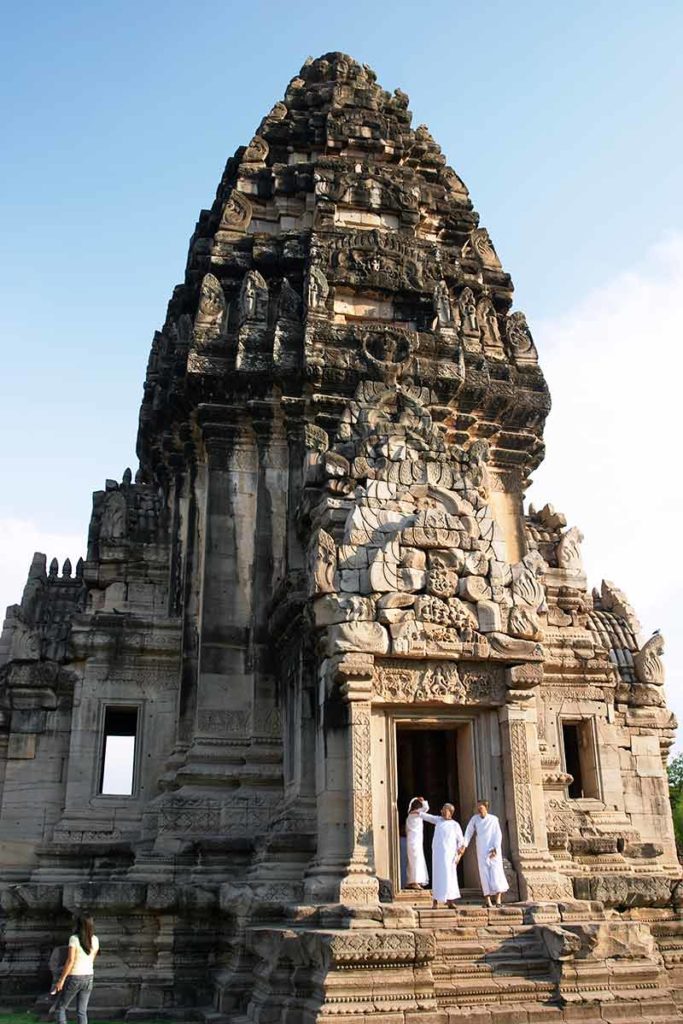
Dating back to the 11th century, Prasat Hin Phimai is one of the oldest temples in Thailand and a landmark of Khmer architecture in Isaan.
Located in Phimai Historical Park, the temple is Thailand’s version of Cambodia’s Angkor Wat and surrounded by moats, walls, ponds and bridges.
The Khmer kings who built Prasat Hin Phimai believed themselves to be the human representations of the Hindu God Shiva so they built temples to edify this godly status and to spread their religion.
Once a major city in the Khmer Empire, Phimai was lost to modern civilisation until a French explorer rediscovered it in 1901.
Although Phimai Historical Park was part of the Khmer Empire and built similarly to Angkor Wat, there are both Buddhist and Hindu influences here.
Stay at: Phimai Paradise Boutique Hotel
14- Phnom Rung Historical Park
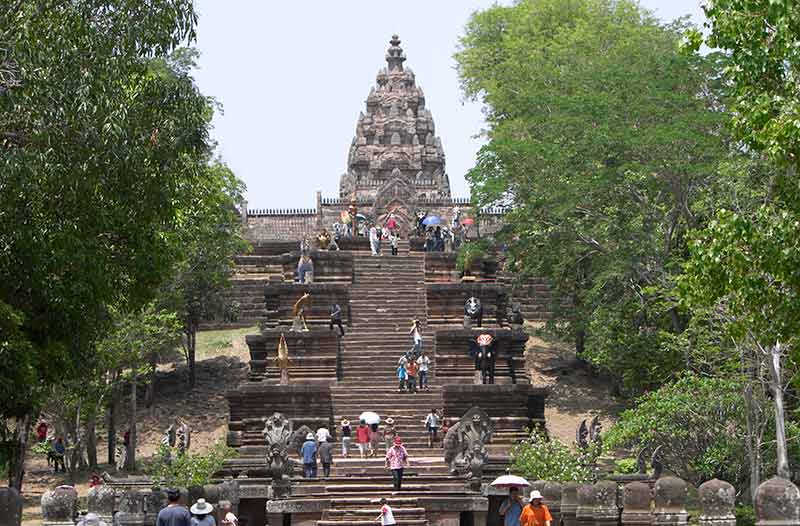
In Buri Ram province in northeast Thailand lies a mysterious Khmer temple complex built on the rim of extinct volcanic.
Like Prasat Hin Phimai, during the 10th to the 13th centuries, Phnom Rung was a Hindu temple complex used to worship Shiva.
The temple was constructed so that four times a year, sunlight shines through the lingam in the east-facing temple through 15 doorways right through to the other side.
Visit during April, September, March and October to see this peculiar occurrence and enjoy Khmer architecture.
Stay at: COZY SHIROI RESORT
15- White Temple
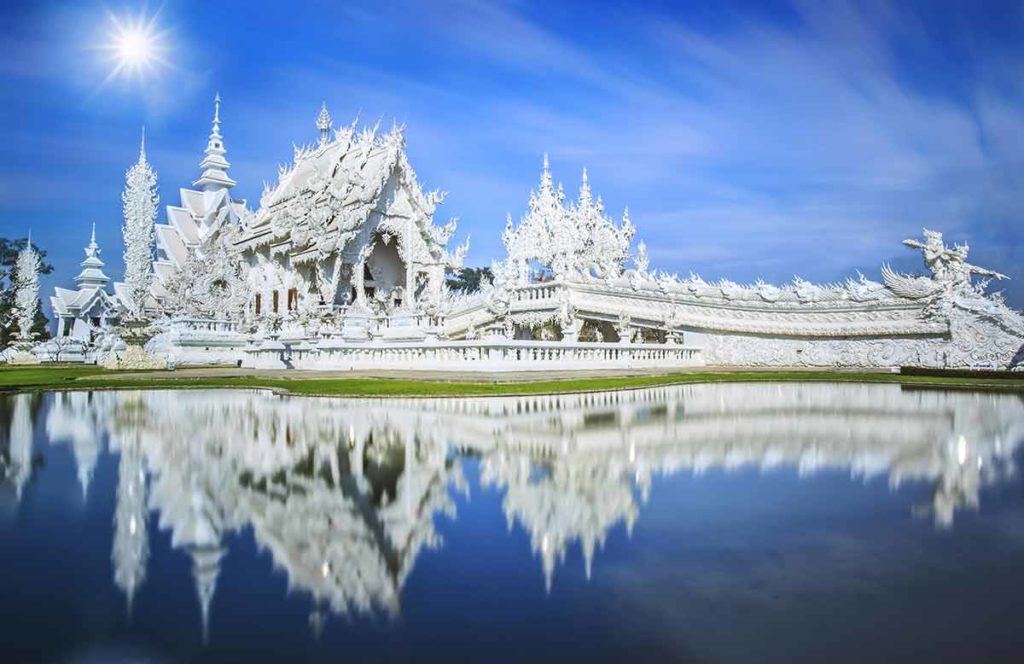
Wat Rong Khun (White Temple) is one of the spectacular landmarks in Thailand.
Constructed in 1997 in Chiang mai, the White Temple is an artistic creation and a contemporary passion project built by Thai artist Ajarn Chalermchai Kositpipat.
The privately funded temple has ornate gates, stunning sculptures and a three-tiered roof inspired by traditional Thai Buddhist temple design.
A unique aspect of the White Temple is that internal paintings feature famous characters such as Hello Kitty, Spiderman and Darth Vader.
You may like this tour of Wat Rong Khun and other temples in Chiang mai.
Stay at: MORA Boutique Hotel – SHA Extra Plus
16- Wat Muang
With Buddha statues all over Thailand, the Land of A Thousand Smiles could also be called the Land of A Thousand Buddha’s.
Of all the sitting, standing and reclining Buddha’s, the Buddha at Wat Muang is the biggest.
What makes Wat Muang even more spectacular is the seated Buddha is 92 m high and is an imposing Thai landmark surrounded by farmland.
The temple is in the Ang Thong Province in central Thailand, 100 km to the north of Bangkok.
Stay at: The Box Promkiri
17- Ban Chiang
It’s not surprising that Thailand is where you will find the remains of the most significant Southeast Asian prehistoric settlement.
The Ban Chiang Archaeological Site has pottery, skeletons and other artifacts from prehistoric times making it one of the most fascinating historical sites in Thailand.
Items discovered include bronze jewellery, such as bracelets, rings and anklets, and weapons like spears, axes and blades.
The area practised wet-rice culture and was one of the earliest prehistoric farming sites.
Experts believe that Ban Chiang was occupied from 1495 BC to 900 BC.
Ban Chiang is in Nong Han District, Udon Thani Province, Thailand.
Stay at: La bonita Chiang Mai
18- Wat Chedi Luang
Wat Chedi Luang, located in the heart of Chiang Mai, Thailand, is one of the city’s most significant and revered temples.
Built in the 14th century, the temple’s iconic chedi (stupa) once stood over 80 meters tall but was partially destroyed by an earthquake in the 16th century.
Despite this, the towering ruins remain awe-inspiring, reflecting the grandeur of Lanna architecture.
The temple also houses the revered city pillar shrine and was once the home of the Emerald Buddha, now in Bangkok.
Wat Chedi Luang is a must-visit for history enthusiasts, those interested in traditional Thai architecture and those seeking cultural insight into Thailand’s rich spiritual traditions.
Stay at: Smile Lanna Hotel
19- Maekhlong Railway Market
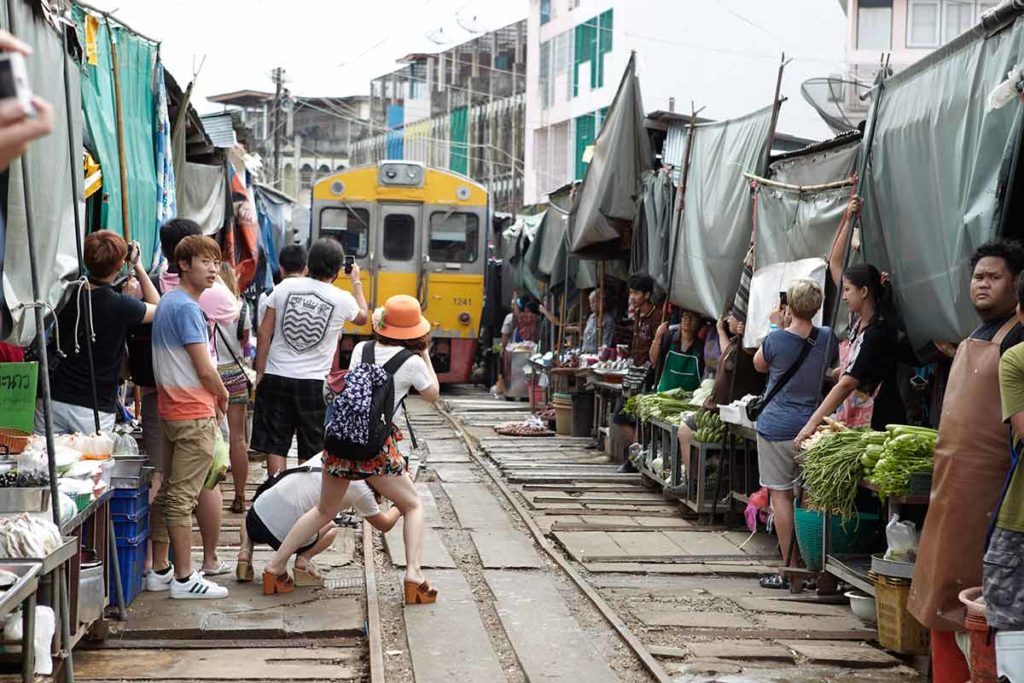
Although there are many markets in Thailand, one that stands out as a Thai landmark is the Maeklong Railway Market.
The unique thing about this market is that the railway track cuts through the centre of the market.
A train rolls along this track several times a day and it’s fascinating to watch the stallholders fold up their stalls to let the train pass.
You’ll also find some stalls selling delicious street food.
Stay at: Avani Plus Riverside Bangkok Hotel
20- Sanctuary of Truth in Pattaya
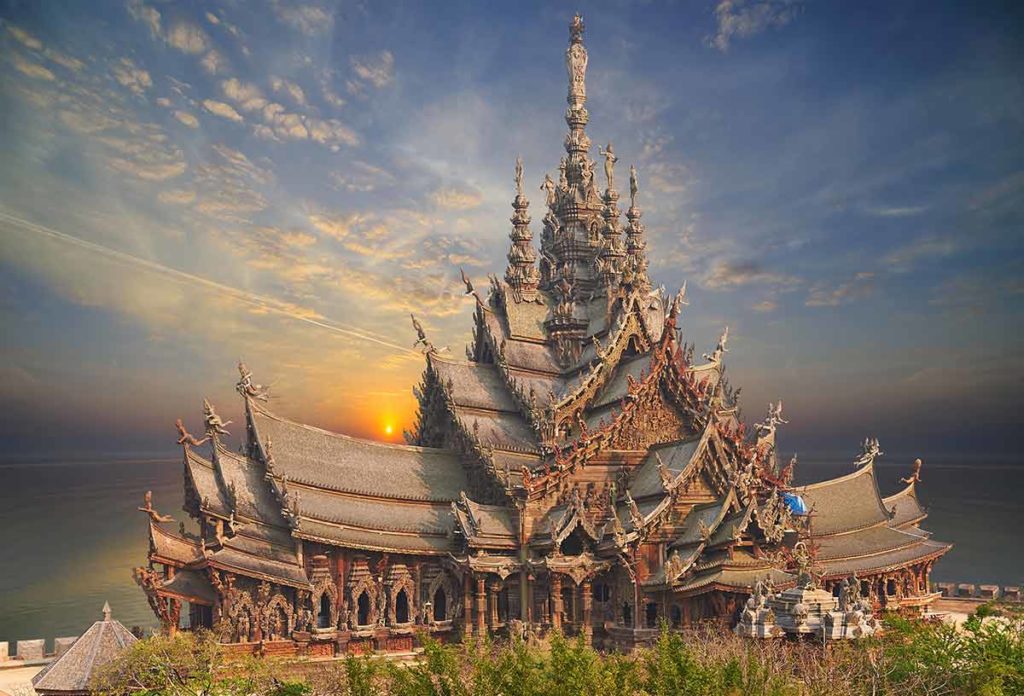
During the reign of King Rama IX, thousands of Thai craftsmen and artisans were brought here to create the wooden castle and to fill its halls with spectacular wood carvings.
With magnificent hand-carved pillars and artisan sculptures, the Sanctuary of Truth tells stories in wood.
Halls are based around a theme, such as the Northern Hall, which is all about spiritual development and where sculptures are artistic representations of Taoism, Confucianism and Buddhism.
In the Southern Hall, the artistry revolves around the sun, the moon and the planets and how they influence the earth.
The Sanctuary of Truth is at 206/2 Moo 5, Soi Naklua 12, Naklua, Banglamung, Chonburi. You can easily visit Pattaya on a day trip from Bangkok.
Stay at: Grande Centre Point Pattaya
Also read:
- 30 Things To Do In Bangkok
- 22 Famous Landmarks In Thailand
- 22 Things To Do In Isaan
- Bangkok To Ayutthaya Day Tour
- Bangkok Shopping Guide
- Where To Buy Thai Silk
- Thailand Itinerary (2 weeks)
- When is The Best Time To Visit Thailand?
- 20 Thailand Drinks To Try
- Bangkok At Night
- 15 Floating Markets In Bangkok And Beyond
- Where To Stay In Phuket
- Where To Stay In Bangkok
- A Guide To Phuket’s Old Town
- 20 Things To Do In Phuket
- 20 Islands In Thailand
- 20 Thai Cities To Visit
- 20 Things To Do In Chiangmai
- Chiangmai At Night
- 20 Thai Food Dishes
- Everything You Need To Know About Living in Thailand
- 15 Things Thailand Is Famous For
- 20 Overwater Bungalows In Thailand
Natural Thailand Landmarks
21- Doi Inthanon Mountain
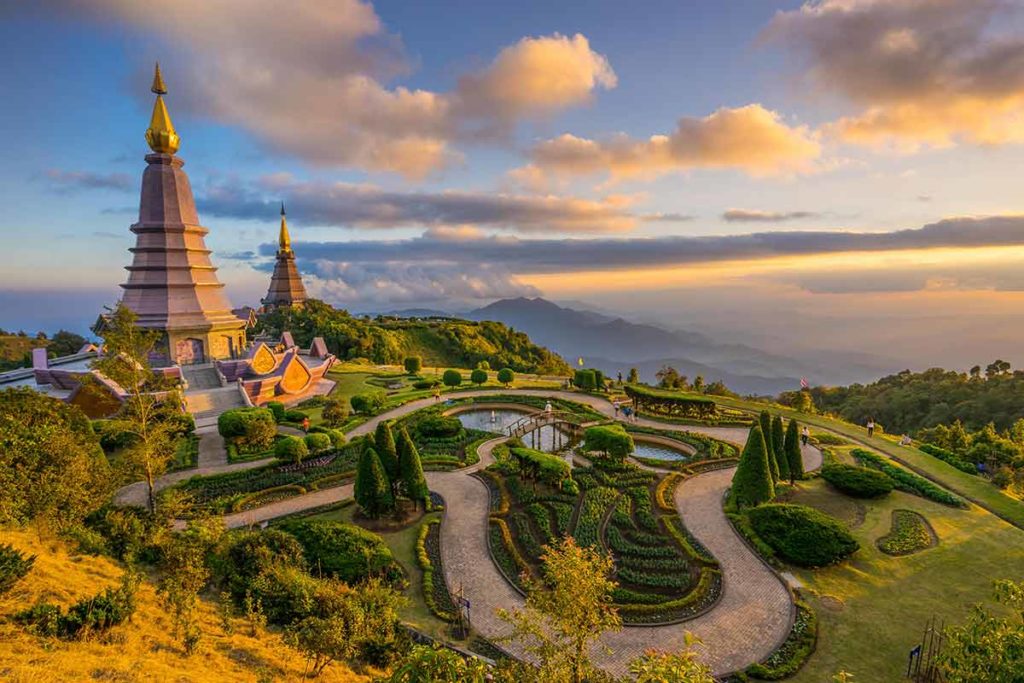
Waterfalls, hiking trails, farms and villages form the intriguing mosaic of Doi Inthanon National Park.
The national park southwest of Chiang Mai is “The Roof of Thailand” as it’s part of the Himalayan mountain range.
With peaks between 800 and 2,565 m high, the national park is home to Thailand’s tallest mountain.
Doi Inthanon Mountain is a Thailand landmark worth visiting as it’s the highest mountain in Thailand.
Visit the summit for the view.
The best place to enjoy the sunrise at Doi Inthanon is from the Two Chedis.
The entrance fee to Doi Inthanon is 300 Baht and you can easily explore the national park by taxi (around 3000 Baht) or join a guided tour.
Stay at: Smile Lanna Hotel
22- James Bond Island (Khao Ping Kan)
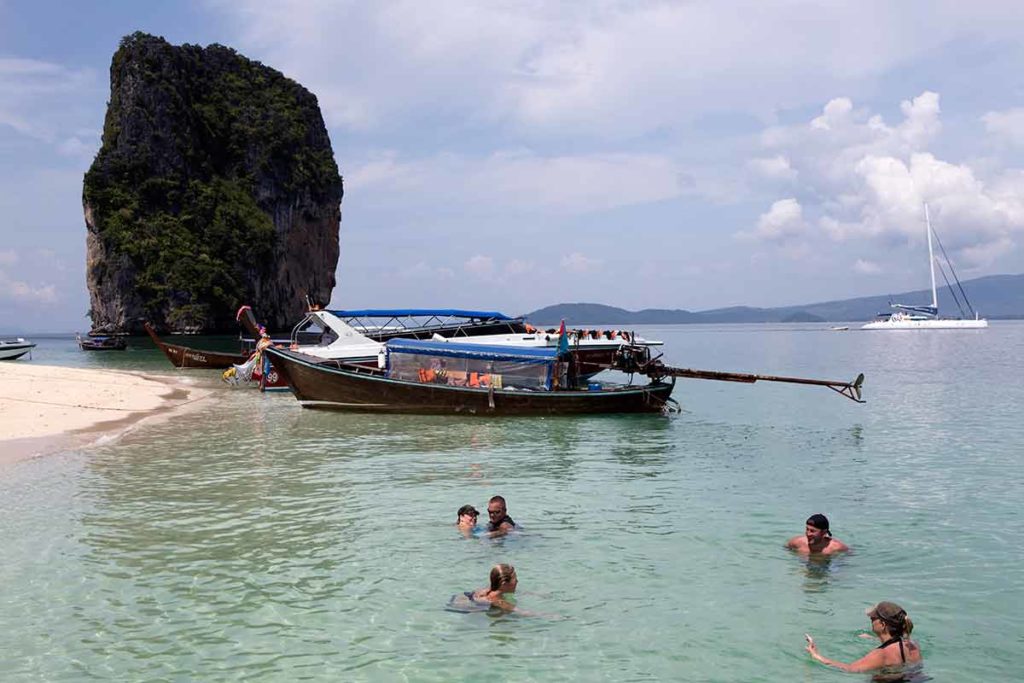
Some of the most stunning natural landmarks in Thailand are located in scenic Phang Nga Bay.
The one that stands out is an island called Khao Phing Kan that shot to worldwide fame when it was the filming location for The Man with the Golden Gun.
That’s why Khao Phing Kan is better-known as James Bond Island.
The area is characterised by striking limestone karst towers, with the most iconic being Ko Ta Pu — a 20-meter tall islet that dramatically rises from the emerald waters.
With stunning beaches and striking limestone formations thrusting straight up towards the sky, this island is a popular destination for day-trippers from Phuket or Krabi.
Stay at: TreeHouse Villas
23- Erawan Waterfall
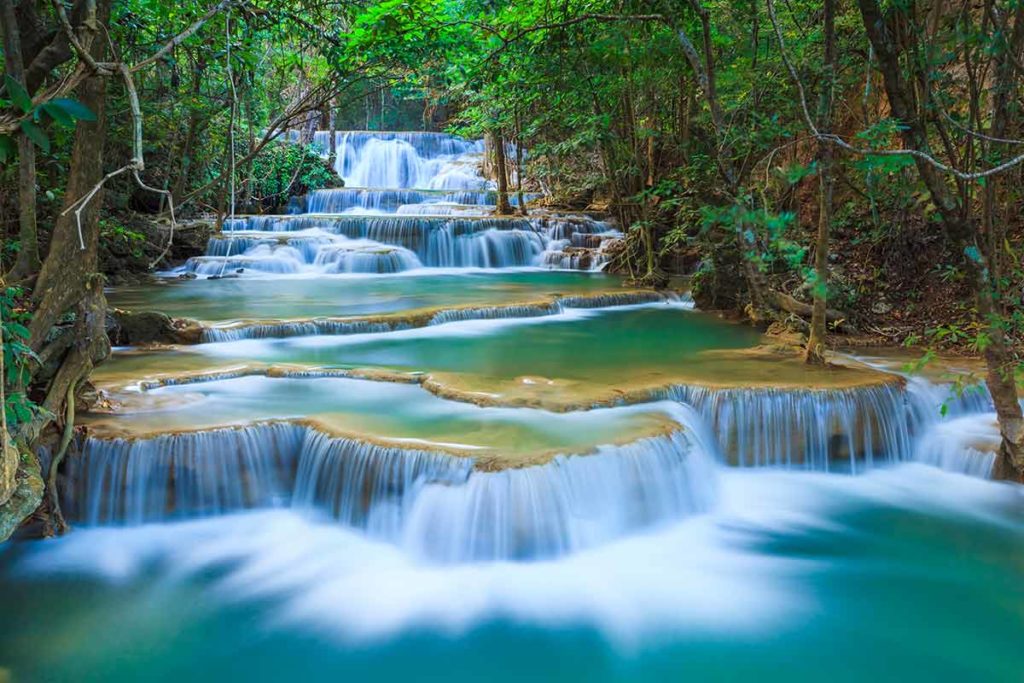
The seven-level Erawan Waterfall is a 1.5km the jewel of Erawan National Park and one of the most stunning natural landmarks in Thailand.
There’s a trail that runs up along the waterfall crossing the river in several spots, with wooden ladders to help you climb large boulders.
The hike takes around an hour and if it gets too steamy, you can take a dip in the pools to cool off.
The best way to visit Erawan is to join a tour from Kanchanaburi.
Erawan National Park is at Tha Kradan, Si Sawat District, Kanchanaburi 71250, Thailand. The entrance fee is 300 THB.
Stay at: The Float House River Kwai
24- Haew Suwat Waterfall in Khao Yai National Park
Haew Suwat Waterfall in Khao Yai National Park is a stunning natural landmark known for its picturesque beauty and cinematic fame—it was featured in the movie The Beach.
Cascading 20 m down a rocky cliff into a serene pool, the waterfall is surrounded by lush tropical greenery, making it a photographer’s dream.
Easily accessible via a short hike, Haew Suwat offers a tranquil retreat and a perfect spot to immerse yourself in nature’s splendor.
Stay at: MUTHI MAYA Forest Pool Villa Resort
25- Cheow Lan Lake in Khao Sok National Park
Cheow Lan Lake, nestled in Thailand’s Khao Sok National Park, is a mesmerising gem renowned for its turquoise waters and dramatic limestone karsts.
This man-made lake, created by the Ratchaprapha Dam, offers a surreal landscape of towering cliffs, hidden caves, and floating bamboo bungalows.
Visitors can explore its beauty by boat, kayak or even stay overnight for an immersive experience.
Cheow Lan Lake’s tranquil ambiance and breathtaking scenery make it a must-visit destination for nature lovers and adventurers alike.
Stay at: 286poolvilla
26- Maya Bay
Maya Bay, located on the island of Koh Phi Phi Leh in Thailand, is a world-famous destination known for its breathtaking beauty.
Surrounded by towering limestone cliffs and crystal-clear turquoise waters, the bay is framed by soft white sand beaches and vibrant coral reefs teeming with marine life.
Maya Bay gained global fame after featuring in the 2000 movie The Beach, starring Leonardo DiCaprio.
Its stunning scenery attracts visitors seeking snorkeling, swimming, and serene views.
To protect its delicate ecosystem, the bay has undergone conservation efforts, including regulated visitor access, making it a paradise for nature lovers and responsible travelers alike.
Stay at: Zeavola Resort
27- Thi Lo Su Waterfall
Thi Lo Su Waterfall, located in Umphang Wildlife Sanctuary in Tak Province, is Thailand’s largest and most breathtaking waterfall.
Cascading nearly 300 meters across multiple tiers, it is surrounded by lush tropical forest, creating a dramatic and picturesque setting.
Accessible via a scenic trek or boat ride during the rainy season, the journey to Thi Lo Su is as thrilling as the destination itself.
This UNESCO-listed site is a haven for nature lovers, offering opportunities for swimming, photography, and birdwatching.
Its pristine beauty and unspoiled surroundings make Thi Lo Su Waterfall a must-visit landmark for adventurers exploring Thailand’s natural wonders.
Stay at: Umphangburiresort
28- Emerald Pool (Sa Morakot)
Emerald Pool (Sa Morakot), located in Krabi, Thailand, is a natural wonder renowned for its crystal-clear, emerald-green waters.
Nestled within Thung Teao Forest Natural Park, this enchanting pool is surrounded by lush rainforest, making it a serene and picturesque escape. Visitors can enjoy a refreshing swim in its warm mineral waters, which are fed by natural springs.
A short trek through a nature trail leads to the pool, offering opportunities to spot unique wildlife and vibrant flora along the way.
The Emerald Pool is a must-visit destination, perfect for relaxation and immersing yourself in Thailand’s stunning natural beauty.
Stay at: Koh Jum Beach Villas “A member of Secret Retreats”
29- Sam Phan Bok
Sam Phan Bok, also known as the “Grand Canyon of Thailand,” is a breathtaking natural wonder located along the Mekong River in Ubon Ratchathani Province.
Its name translates to “3,000 holes,” referring to the thousands of unique rock formations and potholes carved by water erosion over millennia.
These stunning sandstone formations are especially captivating during the dry season when the river recedes, revealing intricate patterns and pools.
The site’s surreal landscape, with its honeycomb-like textures and mesmerizing shapes, offers incredible photography opportunities, particularly during sunrise and sunset.
Sam Phan Bok is a must-see destination for nature lovers and adventurers.
Stay at: Katathong Golf Resort & Spa
30- The Red Lotus Sea (Talay Bua Daeng)
The Red Lotus Sea (Talay Bua Daeng), located in Nong Han Lake near Udon Thani, Thailand, is a magical natural spectacle.
Every winter, from December to February, the lake transforms into a vibrant sea of blooming pink and red lotus flowers, creating an ethereal landscape.
Visitors can explore the lake on traditional wooden boats, gliding through endless stretches of floating blossoms, with birds and aquatic life adding to the serene ambiance.
Best experienced during the early morning hours, when the flowers are fully open, the Red Lotus Sea offers a unique and unforgettable glimpse of Thailand’s natural beauty and tranquility.
Stay at: De Princess Hotel Udonthani
31- Pha Taem National Park
Pha Taem National Park in Ubon Ratchathani Province is a captivating natural and cultural treasure./p>
Known for its breathtaking cliffs overlooking the Mekong River, the park offers stunning sunrise views, especially from the iconic Pha Taem Cliff. It is also famous for prehistoric rock paintings, estimated to be over 3,000 years old, depicting ancient ways of life.
The park’s diverse landscape includes lush forests, sandstone formations, and unique wildflower fields that bloom seasonally.
Rich in history and natural beauty, Pha Taem is a must-visit destination for adventurers, nature lovers, and those interested in Thailand’s ancient heritage.
Stay at: Velawarin Hotel
Discover more Famous World Landmarks:
- 30 Australian Landmarks
- 20 New Zealand Landmarks
- 22 African Landmarks
- 21 Egyptian Landmarks
- 20 Jordan Landmarks
- 10 Tasmanian Landmarks
- 20 Antarctica Landmarks
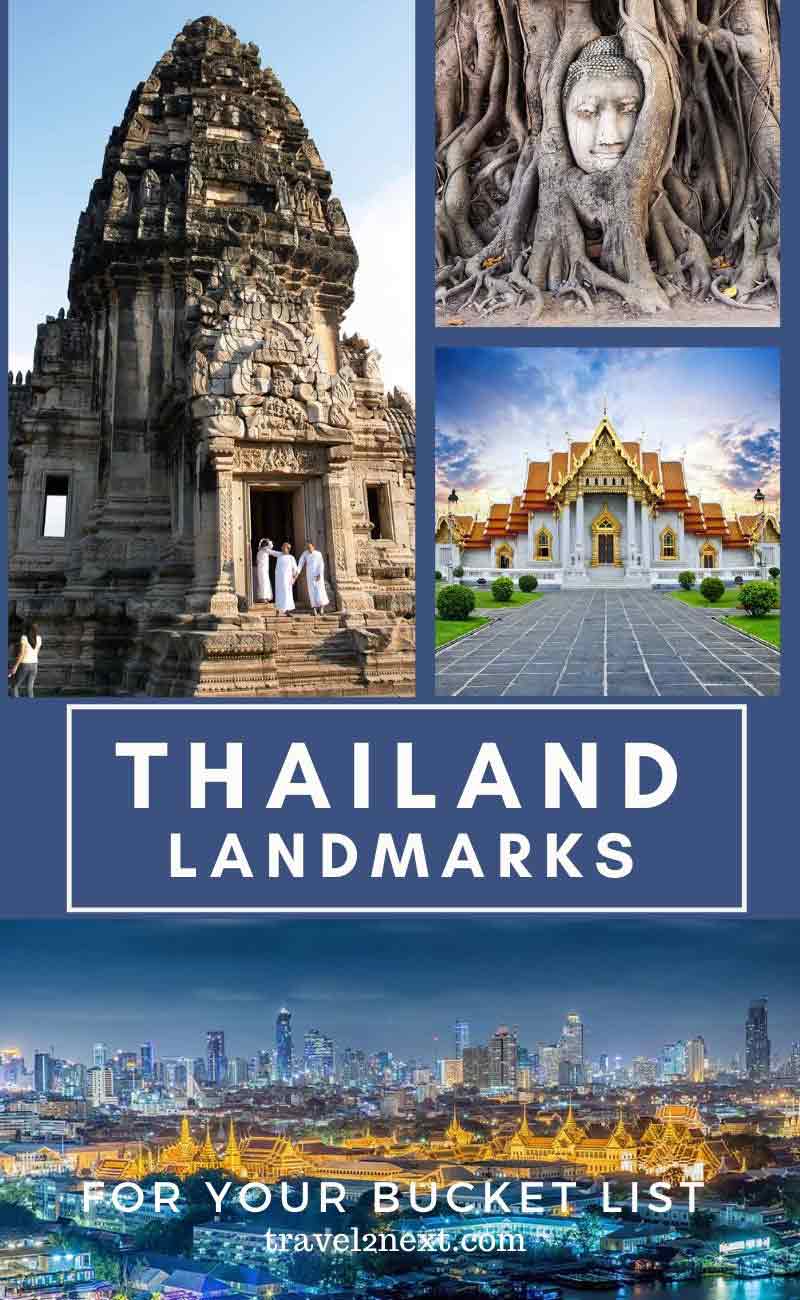
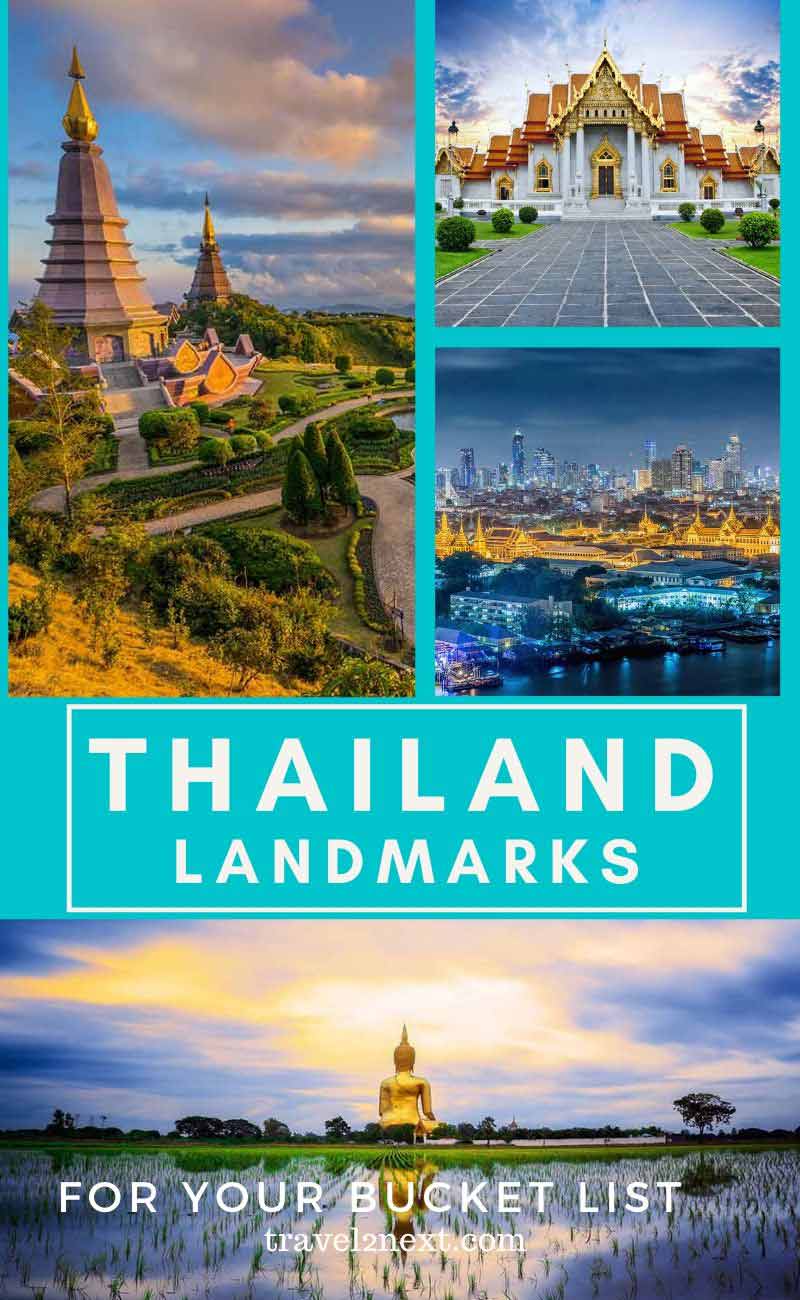
Plan Your Trip

Rent A Car – Find the best car rental rates at Discover Cars. They compare car hire companies to provide you with the best deal right now.

Find A Hotel – If you’re curious about this article and are looking for somewhere to stay, take a look at these amazing hotels.
